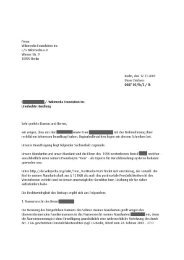Proceedings
Proceedings
Proceedings
You also want an ePaper? Increase the reach of your titles
YUMPU automatically turns print PDFs into web optimized ePapers that Google loves.
| 98<br />
medium, the problem of critical code getting compromised has, in fact, not really been<br />
solved. The most efficient way to attack a system like this would most likely be by<br />
compromising the code on the removable medium.<br />
It is therefore crucial that the user keep the removable medium with him or her at all<br />
times. If there is the slightest reason to believe that the data on it may have been<br />
compromised, its contents must be erased and reconstructed according to the instructions<br />
in the respective GBDE or GELI chapters.<br />
If the removable medium has been lost or stolen and there was a keyfile or lockfile<br />
stored on it, then two issue must be taken into account:<br />
� The user will not be able to access to encrypted data even with the passphrase.<br />
It is therefore strongly recommended that a backup of the keyfile/lockfile be<br />
made and kept in a secure place – preferably without network connectivity.<br />
� The second possibility can be equally devastating, since the keyfile/lockfile<br />
could fall into the hands of someone who is determined to break into the<br />
system. In that case, all the attacker needs is the passphrase – which can be very<br />
hard to keep secret for a mobile device. It is therefore recommended that both<br />
the passphrase and the keyfile/lockfile are changed in the event of a removable<br />
medium loss or theft.<br />
��������������<br />
Complete hard disk encryption offers protection against specific attacks as discussed in<br />
chapter 4.1. This additional protection, however, comes at a cost – which is usually why<br />
security measures are not enabled by default. In the case of complete hard disk<br />
encryption, the trade-offs worth mentioning the most are the following:<br />
� Performance. Encryption and decryption consume a lot of processing power.<br />
Since each I/O operation on the encrypted hard disk requires additional<br />
computation, the throughput is often limited by the power of the CPU(s) and<br />
not the bandwidth of the storage medium. Especially write operations, which<br />
must be encrypted, are noticeably slower than read operations, where<br />
decryption is performed. Systems which must frequently swap out data to<br />
secondary storage and therefore usually to the encrypted hard disk can suffer<br />
from an enormous performance penalty. In cases where performance becomes<br />
too big a problem it is suggested that dedicated hardware be used for<br />
cryptographic operations. GELI supports this by using the crypto(9) framework,<br />
GBDE unfortunately does so far not allow for dedicated hardware to be used<br />
and must therefore rely on the CPU(s) instead.<br />
� Convenience. Each time the system is booted, the user is required to attach or<br />
insert the removable medium and enter the passphrase. Booting off a<br />
removable medium is usually slower than booting from a hard disk and the<br />
passphrase introduces an additional delay.<br />
� Administrative work. Obviously the whole scheme must first be set up before it<br />
can be used. The majority of this quite lengthy process must also be repeated<br />
with each system upgrade as the code on the removable medium must not get<br />
out of sync with the code on the hard disk. As this set-up or upgrade process is<br />
also prone to errors such as typos, it may be considered an additional risk to the<br />
data stored on the device.<br />
-22-






